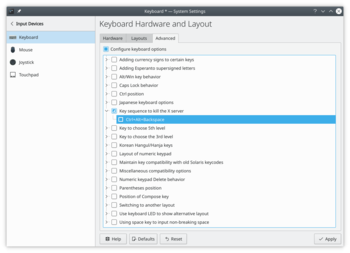System Settings/Input Devices/zh-cn: Difference between revisions
(Updating to match new version of source page) |
(Updating to match new version of source page) |
||
| Line 21: | Line 21: | ||
To enable this feature, first make sure <menuchoice>Configure keyboard options</menuchoice> is enabled under <menuchoice>Advanced</menuchoice> tab. Then, check a key from <menuchoice>Compose key position</menuchoice> tree. Finally, click <menuchoice>Apply</menuchoice>. From now on, you will be able to use that key as Compose key. | To enable this feature, first make sure <menuchoice>Configure keyboard options</menuchoice> is enabled under <menuchoice>Advanced</menuchoice> tab. Then, check a key from <menuchoice>Compose key position</menuchoice> tree. Finally, click <menuchoice>Apply</menuchoice>. From now on, you will be able to use that key as Compose key. | ||
<span class="mw-translate-fuzzy"> | |||
[[Category:桌面/zh-cn]] | [[Category:桌面/zh-cn]] | ||
[[Category:系统/zh-cn]] | [[Category:系统/zh-cn]] | ||
</span> | |||
Revision as of 15:55, 12 July 2011
键盘
启用 Control + Alt + Backspace 键结束 X-Server 进程
在标签页里,确认选中。然后在下边的列表里找到"Key sequence to kill the X server",展开之后选中,单击。

Enable Compose key
Compose is a feature that allows you to write any character you want, no matter the keyboard layout you are using, by pressing a certain key (Compose key) and a series of keys. You could, i.e., associate ‘~’ and ‘n’ characters so they get replaced by a ‘ñ’ character when they are pressed after pressing Compose key. There are many default key combinations, and you can customize Compose configuration file so it better fits your specific needs. You will find more information here.
To enable this feature, first make sure is enabled under tab. Then, check a key from tree. Finally, click . From now on, you will be able to use that key as Compose key.
